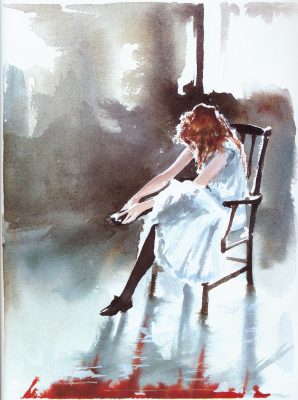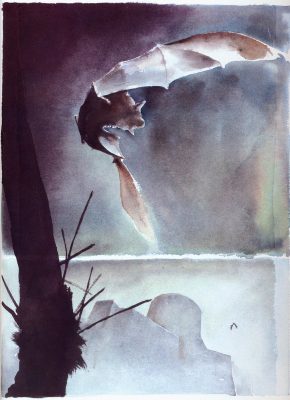Reviewer: Emera
Date read: 3.27.2019
Book from: Personal collection, but Bierce’s work is in the public domain & can be found online for free; see ambrosebierce.org, for example.
The Moonlit Road and Other Ghost & Horror Stories is a collection of twelve of Ambrose Bierce’s stories (selected from 1909 and 1912 collections of his work), published by Dover.
Contents, with my favorites starred: The Eyes of the Panther*, The Moonlit Road, The Boarded Window, The Man and the Snake*, The Secret of Macarger’s Gulch, The Middle Toe of the Right Foot*, A Psychological Shipwreck*, A Holy Terror*, John Bartine’s Watch, Beyond the Wall, A Watcher by the Dead, Moxon’s Master
Sampler o’ themes: Ambiguity of state (dead/alive, woman/animal, natural/supernatural, real/imagined), close intimacy with the dead, fear overcoming men’s rational defenses, the grief and shame of men who have failed to protect the women who loved them
These stories are very smart, very darkly witty, and often wonderfully atmospheric, but for my taste far too reliant on twist endings that can variously come off as silly, obvious, excessively neat, etc. In the worse stories, there’s a tangible sense of self-satisfaction with his own wit – like Bierce is constantly waggling his eyebrows at you while you try to focus on reading.
The best have a deeper sense of elemental weirdness, a real conviction of darkness and not just a desire to titillate and dazzle. In this collection, “The Eyes of the Panther” and “The Man and the Snake” by far maximize this quality of weird darkness, “The Man and the Snake” especially so. While “The Eyes of the Panther” can be fitted into the context of “animal bride” fairy tales (as well as the fact that mountain lion screams sound unnervingly like those of a human woman), “The Man and the Snake” is wonderfully its own thing. It’s deeply idiosyncratic, darkly funny (“A snake in the bedroom of a modern city dwelling of the better sort is, happily, not so common a phenomenon as to make explanation altogether unnecessary”), and simultaneously so vivid and so ambiguous that it’s borderline surreal:
“The snake’s malignant head was still thrust forth from the inner coil as before, the neck level. It had not moved, but its eyes were now electric sparks, radiating an infinity of luminous needles.”
“A Psychological Shipwreck” is also quite compellingly weird; call it a psychic romantic tragedy. In most of these stories I was annoyed/bored by the extent to which Bierce’s female characters serve as blank slates upon which men write their tragic obsessions; the stories, like “Shipwreck,” where the women seem to emanate some supernatural force of their own are commensurately more interesting to me. Hence also my enjoyment of the darkly vital “The Eyes of the Panther.”
Among the more traditional stories, I appreciated “The Middle Toe of the Right Foot” first of all for its hilarious and intriguing title, secondly for introducing me to the folkloric anecdote of Jim Bowie having fought and won a barefoot knife fight in a dark room, and ultimately simply as a grimly satisfying tale of revenge wrought by the occupants of a haunted house. The quick shifts of time and perspective that Bierce often uses felt particularly witty here, almost caper-esque, and there’s also just some delightful haunted-house descriptions.
Finally, “A Holy Terror,” while close to annoyingly twisty, has some fantastically flavorful writing about an abandoned western mining town, which was a much-appreciated complement to my recent reading of Cormac McCarthy’s Blood Meridian. I’ll conclude with my favorite paragraph – peak Bierce:
It is necessary to explain that one of the adjuncts to Hurdy-Gurdy—one to which that metropolis became afterward itself an adjunct—was a cemetery. In the first week of the camp’s existence this had been thoughtfully laid out by a committee of citizens. The day after had been signalized by a debate between two members of the committee, with reference to a more eligible site, and on the third day the necropolis was inaugurated by a double funeral. As the camp had waned the cemetery had waxed; and long before the ultimate inhabitant, victorious alike over the insidious malaria and the forthright revolver, had turned the tail of his pack-ass upon Injun Creek the outlying settlement had become a populous if not popular suburb. And now, when the town was fallen into the sere and yellow leaf of an unlovely senility, the graveyard—though somewhat marred by time and circumstance, and not altogether exempt from innovations in grammar and experiments in orthography, to say nothing of the devastating coyote—answered the humble needs of its denizens with reasonable completeness. It comprised a generous two acres of ground, which with commendable thrift but needless care had been selected for its mineral unworth, contained two or three skeleton trees (one of which had a stout lateral branch from which a weather-wasted rope still significantly dangled), half a hundred gravelly mounds, a score of rude headboards displaying the literary peculiarities above mentioned and a struggling colony of prickly pears. Altogether, God’s Location, as with characteristic reverence it had been called, could justly boast of an indubitably superior quality of desolation. It was in the most thickly settled part of this interesting demesne that Mr. Jefferson Doman staked off his claim. If in the prosecution of his design he should deem it expedient to remove any of the dead they would have the right to be suitably reinterred.
Related reading:
The Haunted Dolls’ House and Other Ghost Stories, by M. R. James (1919, 1925): review by Emera
Best Ghost Stories of J. S. LeFanu (1861-1923): review by Emera
LeFanu II: Haunted houses, gouty judges, over-familiars
Seven Gothic Tales, by Isak Dinesen (1935): review by Emera


